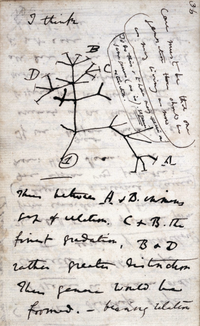
Photo from wikipedia
Selection leading to adaptation to interactions may generate rapid evolutionary feedbacks and drive diversification of species interactions. The challenge is to understand how the many traits of interacting species combine… Click to show full abstract
Selection leading to adaptation to interactions may generate rapid evolutionary feedbacks and drive diversification of species interactions. The challenge is to understand how the many traits of interacting species combine to shape local adaptation in ways directly or indirectly resulting in diversification. We used the well-studied interactions between Lithophragma plants (Saxifragaceae) and Greya moths (Prodoxidae) to evaluate how plants and moths together contribute to local divergence in pollination efficacy. Specifically, we studied L. bolanderi and its two specialized Greya moth pollinators in two contrasting environments in the Sierra Nevada, California. Both moths pollinate L. bolanderi during nectaring, and one of them - G. politella - also while ovipositing through the floral corolla into the ovary. Firstly, field surveys of floral visitors and the presence of G. politella eggs and larvae in developing capsules showed that one population is visited only by G. politella and few other pollinators, whereas the other is visited by both Greya species and other pollinators. Secondly, L. bolanderi in these two natural populations differed in several floral traits putatively important for pollination efficacy. Thirdly, laboratory experiments with greenhouse-grown plants and field-collected moths showed that L. bolanderi is more efficiently pollinated by local compared to non-local nectaring moths of both species. Pollination efficacy of ovipositing G. politella was also higher for local moths for the L. bolanderi population that relies more heavily on this species in nature. Finally, time-lapse photography in the laboratory showed that G. politella from different populations differ in oviposition behavior, suggesting the potential for local adaptation also among Greya populations. Collectively, our results are a rare example of components of local adaptation contributing to divergence in pollination efficiency in a coevolving interaction and, thus, provide insights into how geographic mosaics of coevolution may lead to coevolutionary diversification in species interactions. This article is protected by copyright. All rights reserved.
Journal Title: Ecology
Year Published: 2023
Link to full text (if available)
Share on Social Media: Sign Up to like & get
recommendations!